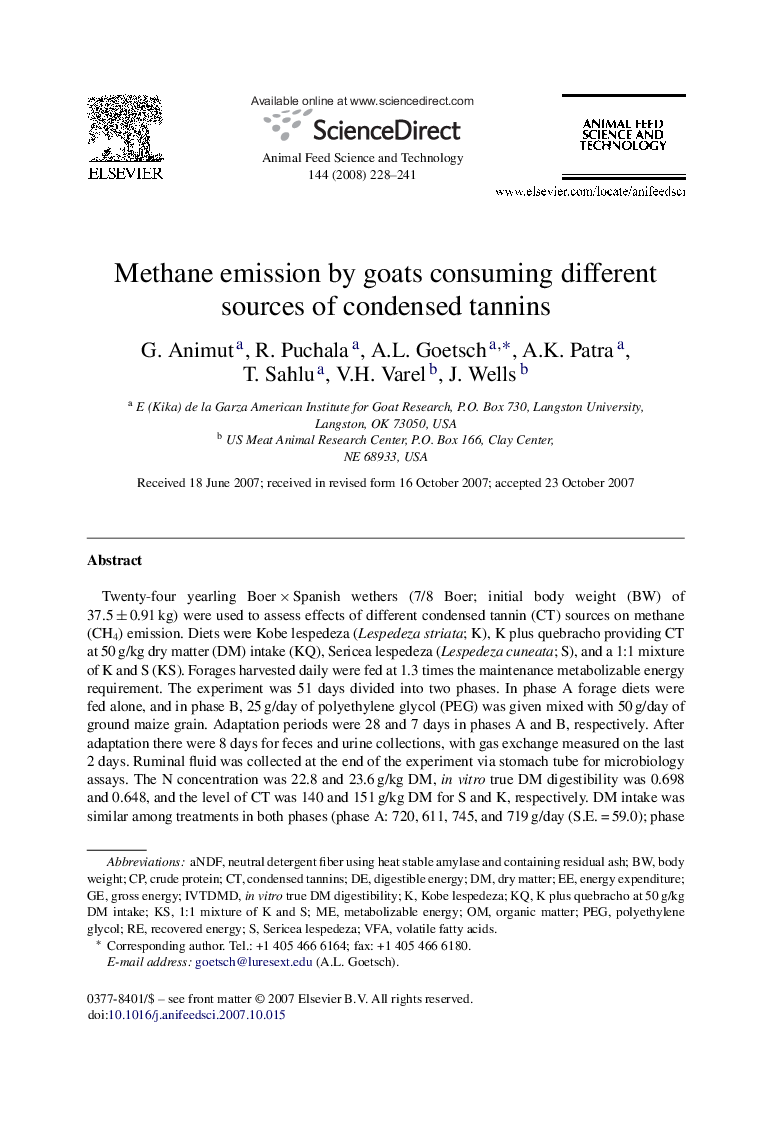| کد مقاله | کد نشریه | سال انتشار | مقاله انگلیسی | نسخه تمام متن |
|---|---|---|---|---|
| 2420778 | 1552468 | 2008 | 14 صفحه PDF | دانلود رایگان |

Twenty-four yearling Boer × Spanish wethers (7/8 Boer; initial body weight (BW) of 37.5 ± 0.91 kg) were used to assess effects of different condensed tannin (CT) sources on methane (CH4) emission. Diets were Kobe lespedeza (Lespedeza striata; K), K plus quebracho providing CT at 50 g/kg dry matter (DM) intake (KQ), Sericea lespedeza (Lespedeza cuneata; S), and a 1:1 mixture of K and S (KS). Forages harvested daily were fed at 1.3 times the maintenance metabolizable energy requirement. The experiment was 51 days divided into two phases. In phase A forage diets were fed alone, and in phase B, 25 g/day of polyethylene glycol (PEG) was given mixed with 50 g/day of ground maize grain. Adaptation periods were 28 and 7 days in phases A and B, respectively. After adaptation there were 8 days for feces and urine collections, with gas exchange measured on the last 2 days. Ruminal fluid was collected at the end of the experiment via stomach tube for microbiology assays. The N concentration was 22.8 and 23.6 g/kg DM, in vitro true DM digestibility was 0.698 and 0.648, and the level of CT was 140 and 151 g/kg DM for S and K, respectively. DM intake was similar among treatments in both phases (phase A: 720, 611, 745, and 719 g/day (S.E. = 59.0); phase B: 832, 822, 867, and 880 g/day (S.E. = 55.3) for K, KQ, S, and KS, respectively). N digestibility was affected by treatment in phase A (P<0.05) but not in phase B (phase A: 0.514, 0.492, 0.280, and 0.413 (S.E. = 0.0376); phase B: 0.683, 0.650, 0.638, and 0.662 (S.E. = 0.0203) for K, KQ, S, and KS, respectively). Gross energy digestibility was similar among treatments in phase A (0.475, 0.407, 0.393, and 0.411 (S.E. = 0.0353)) but differed among treatments in phase B (0.449, 0.373, 0.353, and 0.409 for K, KQ, S, and KS, respectively (S.E. = 0.0221)) CH4 emission was 9.6, 6.8, 10.6, and 8.9 l/day (S.E. = 1.44) in phase A and 19.0, 16.6, 21.8, and 19.2 l/day (S.E. = 1.51) in phase B for K, KQ, S, and KS, respectively (S.E. = 1.25). When data of both phases were pooled, supplementation with PEG in phase B markedly increased (P<0.05) CH4 emission (9.0 l/day versus 19.1 l/day). In accordance, there was a substantial difference (P<0.05) between phases in in vitro CH4 emission by ruminal fluid incubated for 3 weeks in a methanogenic medium and with other conditions promoting activity by methanogens (11.5 and 22.9 ml in phases A and B, respectively). Counts of total bacteria and protozoa were similar among treatments in both phases, but values were greater (P<0.05) in phase B versus phase A. In summary, CT from different sources had a disparate influence on N digestion, but similar effects on ruminal microbial CH4 emission by goats, possibly by altering activity of ruminal methanogenic bacteria though change in actions of other bacteria and/or protozoa may also be involved.
Journal: Animal Feed Science and Technology - Volume 144, Issues 3–4, 15 July 2008, Pages 228–241